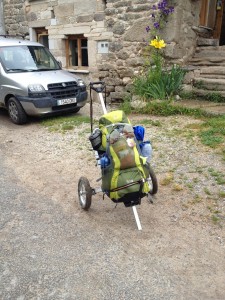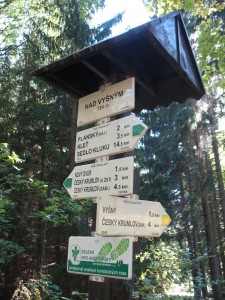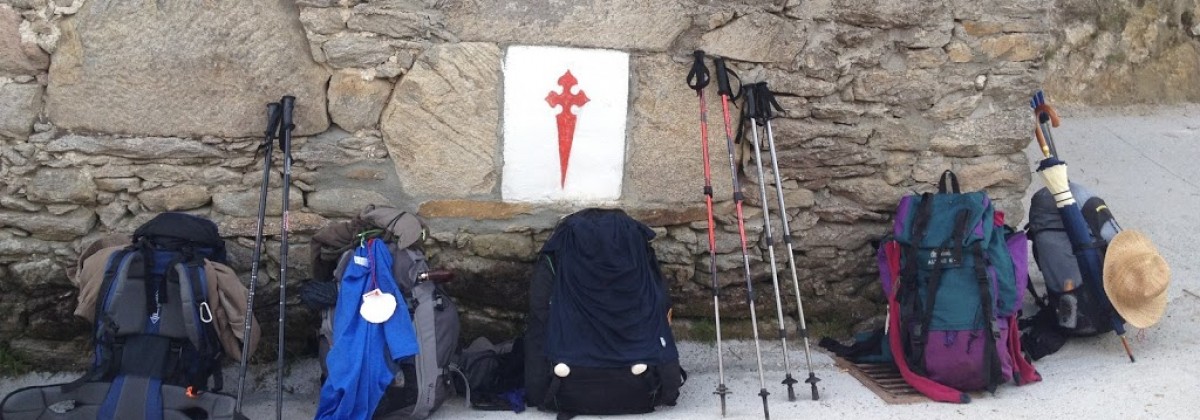 there isn’t much to say about Arzúa or our thirty-third day on the Camino. evidence suggests the town was heavily settled before the arrival of Rome; following the expulsion of the Moors, the people who resettled the area came from the Basque region. it sits in the middle of prime dairy land and we saw warnings for cows crossing the road in many places (as seen below). in recent years, however, increasing tracts of land once used for grazing have been given over to eucalyptus groves, which is harvested and used in furniture and paper production. this proved particularly evident in the hike from Arzúa to Arca. several species were imported from Australia in the 1860s and have proved demanding in the ways of all non-native species — without natural controls, they consume resources local species would otherwise use and suck up copious amounts of water.
there isn’t much to say about Arzúa or our thirty-third day on the Camino. evidence suggests the town was heavily settled before the arrival of Rome; following the expulsion of the Moors, the people who resettled the area came from the Basque region. it sits in the middle of prime dairy land and we saw warnings for cows crossing the road in many places (as seen below). in recent years, however, increasing tracts of land once used for grazing have been given over to eucalyptus groves, which is harvested and used in furniture and paper production. this proved particularly evident in the hike from Arzúa to Arca. several species were imported from Australia in the 1860s and have proved demanding in the ways of all non-native species — without natural controls, they consume resources local species would otherwise use and suck up copious amounts of water. fortunate for the plants forced to compete with the eucalyptus, water is in plentiful supply in Galicia — rain shadow and all. this particular day provided us with deceptively numerous ups and downs, dropping down and climbing out of narrow river valleys and crossing over creeks. outside one shop (perhaps attached to a tiny not-yet-open-for-the-season albergue) we saw one of the more unique pack transportation mechanisms of the Camino: someone had attached their bulging pack to a golf cart. there were lots of places earlier on the Camino where this modification would have been more of a hindrance than a help, but on the well-maintained sendas of Galicia it was probably immensely useful.
fortunate for the plants forced to compete with the eucalyptus, water is in plentiful supply in Galicia — rain shadow and all. this particular day provided us with deceptively numerous ups and downs, dropping down and climbing out of narrow river valleys and crossing over creeks. outside one shop (perhaps attached to a tiny not-yet-open-for-the-season albergue) we saw one of the more unique pack transportation mechanisms of the Camino: someone had attached their bulging pack to a golf cart. there were lots of places earlier on the Camino where this modification would have been more of a hindrance than a help, but on the well-maintained sendas of Galicia it was probably immensely useful.
somewhere earlier on the Camino, when the terrain was still rugged (i.e. before getting into Castilla) we saw a guy with a waist harness that hooked up to a bike-sized trailer with kid-buggy size wheels. unlike the golf cart version, this guy didn’t have to tire his arms out by pulling his stuff behind him; he’d just shifted the weight he carried so it didn’t rest on his shoulders. we saw another, larger cart in a village just outside Astorga. a parent at a cafe saw the cart (painted red with slogans on the sides) and wanted to get a shot of his kid standing atop it. they hoisted the young one up and he let out a wail of dissatisfaction that echoed down the main road.
Tag: maps
a not-so-accidental 800km hike
as most of you know, I spent the month of May hiking across Spain, following in the footsteps of millions of peregrinos — and plenty of non-religious folk — who’ve made the pilgrimage to Santiago de Compostela over centuries.
over 34 days I walked nearly 800 kilometers. 500 miles. over one million steps. approximately the distance from Jacksonville, Florida, to Key West. or Duluth, Minnesota, to Gary, Indiana. however you quantify it: a huge distance and the most physically demanding adventure I’ve ever undertaken.
while Spain was next on my list of places to visit, I can’t take credit for the idea for this trip. I don’t know nearly enough Germans to have come up with an idea as crazy as this. but the person I went with had a friend (a German) who’d done the Camino over several months a couple of years ago and who planted the idea in his head. when it came time to use the four weeks given to him, the Camino wasn’t just the obvious choice, it was the only choice. so we planned, booked our flights, figured out transportation to our starting point, took long practice hikes that couldn’t really prepare us for the physical demands we’d face, booked hotels in many towns and trusted to the Camino infrastructure elsewhere and, on May 4, headed to the airport.
our guidebook proved unhelpful in explaining the most interesting cultural and historical sites we passed (more than enough on all the religious and “mystical” sites to our continual chagrin), which just means I’ll have my research cut out for me as I prepare posts for here. we’ve now sorted through all the photos, so the first phase of getting posts ready has concluded — stay tuned over the next several weeks for more about our adventures!
View Camino de Santiago in a larger map
a little pension luxury
after spending a week sleeping on planes and in hostels, I relished the idea of spending a night in a town too small to have something so large as a multi-bed hostel. after staying an extra night in Český Krumlov I had one free night before my reservation in Olomouc. because Czech Republic is relatively small (by U.S. standards, at least — it’s about the same area as Ireland) the drive from the former to the latter is only about four hours, though something closer to six by bus via a slightly more complicated route.
 consequently, I had a rather extensive list of places I could explore for twelve hours as resting place on my way to Olomouc via Brno. on the recommendation of a fellow traveler I’d met at the Krumlov House (whose opinion validated those of both my guidebooks), I settled on Telč, a town of about 5,800 people on the road to Třebíč and Brno. established in the 14th century as a water fort, the town is now best known for its impeccably-preserved and colossal main square. after the death of Moravian governor Lord Zachariáš in 1589, construction around the square ceased and it has remained largely unchanged since then. (the square is named after him: náměstí Zachariáše z Hradce.)
consequently, I had a rather extensive list of places I could explore for twelve hours as resting place on my way to Olomouc via Brno. on the recommendation of a fellow traveler I’d met at the Krumlov House (whose opinion validated those of both my guidebooks), I settled on Telč, a town of about 5,800 people on the road to Třebíč and Brno. established in the 14th century as a water fort, the town is now best known for its impeccably-preserved and colossal main square. after the death of Moravian governor Lord Zachariáš in 1589, construction around the square ceased and it has remained largely unchanged since then. (the square is named after him: náměstí Zachariáše z Hradce.)
View Larger Map
 apart from the square and the castle (which closed about an hour after I arrived in town), Telč didn’t offer much in the way of sights to occupy me. after dinner of Kozel and an extremely odd pizza with Czech-ketchup sauce (apparently quite popular but so, so, so odd) overlooking the square, followed by a walk around town that took all of 15 minutes, I retired to my private (en suite!) room at a pension on the square. sticking my head out through the skylight of my room, I could see one of the two artificial defensive ponds that enclose the center of town. rooms at the back of the pension had an exceptional view of both the back garden and pond beyond, while the owner’s apartments at the front overlooked the town square. imagine living behind a six century old facade, running a business that overlooks a pond built to defend a 16th century castle? (if you ever find yourself in Telč, check out the Pension Steidler — nice people, great location, and the most extensive breakfast I had my entire trip.)
apart from the square and the castle (which closed about an hour after I arrived in town), Telč didn’t offer much in the way of sights to occupy me. after dinner of Kozel and an extremely odd pizza with Czech-ketchup sauce (apparently quite popular but so, so, so odd) overlooking the square, followed by a walk around town that took all of 15 minutes, I retired to my private (en suite!) room at a pension on the square. sticking my head out through the skylight of my room, I could see one of the two artificial defensive ponds that enclose the center of town. rooms at the back of the pension had an exceptional view of both the back garden and pond beyond, while the owner’s apartments at the front overlooked the town square. imagine living behind a six century old facade, running a business that overlooks a pond built to defend a 16th century castle? (if you ever find yourself in Telč, check out the Pension Steidler — nice people, great location, and the most extensive breakfast I had my entire trip.)

a pedometer would be handy
 after some consideration, I’ve settled on a unifying element of my trip to the Czech Republic: walking. my accidental 28km hike was just one of many foot-borne excursions I enjoyed during my travels. Czechs, I came to understand, enjoy their outdoor activities and hiking and biking trails snake everywhere across the countryside. before I left, I spotted tips in my guidebook for people looking to hike the length of either the Czech Republic or Slovakia and thought the idea absurd — what country has the hiking infrastructure to allow people to hike that far? to make an enjoyable vacation out of the activity?
after some consideration, I’ve settled on a unifying element of my trip to the Czech Republic: walking. my accidental 28km hike was just one of many foot-borne excursions I enjoyed during my travels. Czechs, I came to understand, enjoy their outdoor activities and hiking and biking trails snake everywhere across the countryside. before I left, I spotted tips in my guidebook for people looking to hike the length of either the Czech Republic or Slovakia and thought the idea absurd — what country has the hiking infrastructure to allow people to hike that far? to make an enjoyable vacation out of the activity?
 the Czech Republic, I now know, for one. presumably Slovakia for another.
the Czech Republic, I now know, for one. presumably Slovakia for another.
I went into a bookstore in Wenceslas Square in Prague looking for a standard, nationwide roadmap like the one I got in Ireland and there were nearly as many detailed local and regional ordinance survey recreational maps as there were for maps for the rest of the world. walks around Český Krumlov, around Prague, around Štramberk, around Olomouc, around Brno, around the Mikulov region … you name it, there was a recreation map to cover your needs. maybe two.
however, for those like me who don’t deem such detailed ordinance maps necessary, the trails are so adequately marked that you’ll do all right without them. as long as you know your destination, or the next town on your path, then the periodic signposts and painted markings on trees and farmhouse corners will lead you in the right direction. of course, you might be better off to have the hyper-detailed maps (or at least to consult them during a planning stage) so that you don’t end up hiking three times farther than you think you will hike and run most of the way back to town so as not to miss the last bus back to where you’re spending the night … but that adventure is for another post.







